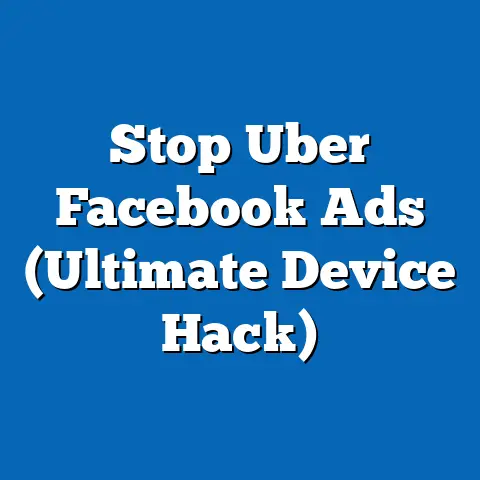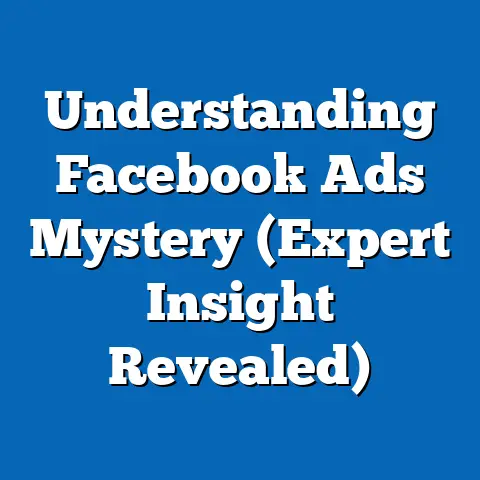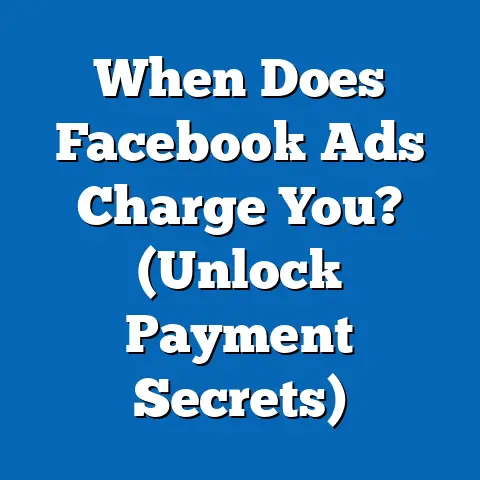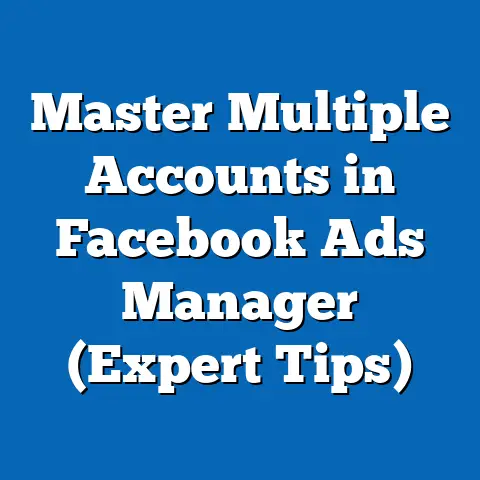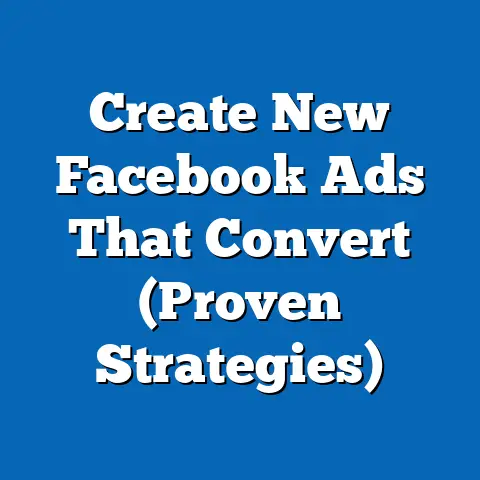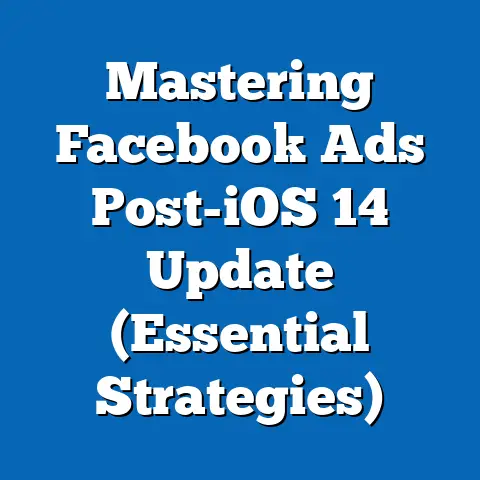Boost Sales with Buying Type Facebook Ads (Expert Tactics)
The world of eCommerce is booming. Recent years have witnessed an explosive surge in online sales, fueled by evolving consumer behavior that increasingly favors digital platforms. The pandemic only accelerated this trend, pushing more and more people to shop from the comfort of their homes. For businesses, this means one thing: a massive opportunity to tap into a vast and growing online marketplace. But simply having an online presence isn’t enough. You need a strategic approach to reach your target audience and drive sales. And that’s where Facebook ads come in.
I’ve seen firsthand how Facebook advertising, when done right, can be a game-changer for businesses of all sizes. However, many marketers fall into the trap of treating all Facebook ads the same. They fail to recognize the nuances of different buying types and how to tailor their campaigns accordingly. This is a critical mistake because understanding and leveraging these buying types is essential for maximizing your advertising ROI and achieving your sales goals.
Understanding Buying Types in Facebook Ads
In the dynamic landscape of Facebook advertising, understanding the various “buying types” is crucial for crafting effective campaigns that drive sales. These buying types essentially represent different optimization goals you can set for your ads, influencing how Facebook delivers your ads to users and how you pay for them. Think of them as different paths you can guide your potential customers down, each tailored to a specific stage of their buying journey.
-
Link Clicks: This buying type focuses on driving traffic to your website or landing page. Facebook optimizes your ads to reach people most likely to click on the link in your ad and visit your specified URL.
-
Conversions: When you choose conversions as your buying type, you’re telling Facebook to find people who are most likely to take a specific action on your website, such as making a purchase, filling out a form, or signing up for a newsletter. To use this, you’ll need to have the Facebook Pixel installed on your website to track these actions.
-
Catalog Sales: This buying type is specifically designed for eCommerce businesses with a product catalog. It allows you to showcase relevant products from your catalog to people who have shown interest in them or similar products on Facebook.
-
Store Visits: If you have a physical store location, this buying type can help you drive foot traffic. Facebook optimizes your ads to reach people who are likely to visit your store based on their location and interests.
Link Clicks: This buying type focuses on driving traffic to your website or landing page. Facebook optimizes your ads to reach people most likely to click on the link in your ad and visit your specified URL.
Conversions: When you choose conversions as your buying type, you’re telling Facebook to find people who are most likely to take a specific action on your website, such as making a purchase, filling out a form, or signing up for a newsletter. To use this, you’ll need to have the Facebook Pixel installed on your website to track these actions.
Catalog Sales: This buying type is specifically designed for eCommerce businesses with a product catalog. It allows you to showcase relevant products from your catalog to people who have shown interest in them or similar products on Facebook.
Store Visits: If you have a physical store location, this buying type can help you drive foot traffic. Facebook optimizes your ads to reach people who are likely to visit your store based on their location and interests.
Why Understanding Buying Types Matters
Choosing the right buying type is paramount to the success of your Facebook ad campaigns. Imagine trying to sell a high-end luxury item using an ad optimized for link clicks. You might get a lot of traffic to your website, but it’s unlikely to result in many sales because the people clicking on the ad aren’t necessarily ready to make a purchase.
I’ve seen this happen countless times. Businesses focus on vanity metrics like clicks and impressions, without realizing that they’re not translating into actual revenue. By carefully selecting the buying type that aligns with your business goals, you can significantly improve your campaign performance and maximize your ROI.
The Power of Data and Case Studies
Let’s look at some data to illustrate the impact of different buying types. A study by AdEspresso found that conversion-optimized ads had a 2x higher conversion rate compared to link click-optimized ads. This highlights the importance of choosing the right buying type based on your desired outcome.
I remember working with a local clothing boutique that was struggling to drive online sales. They were running Facebook ads optimized for link clicks, which brought a lot of traffic to their website, but very few people were actually buying anything. After analyzing their data, I recommended switching to conversion-optimized ads and targeting people who had previously visited their website or engaged with their social media content. Within a month, their online sales increased by 50%. This experience solidified my belief in the power of strategically selecting the right buying type.
Takeaway
Understanding the different buying types in Facebook ads is fundamental to creating successful campaigns that drive sales. By carefully considering your business goals and target audience, you can choose the buying type that will deliver the best results.
Next Steps:
- Define your business goals: What do you want to achieve with your Facebook ads? Are you trying to drive traffic to your website, generate leads, or increase sales?
- Understand your target audience: Who are you trying to reach with your ads? What are their interests, behaviors, and demographics?
- Choose the right buying type: Based on your goals and target audience, select the buying type that is most likely to deliver the desired results.
Setting Up Your Facebook Ad Campaign for Buying Types
Once you understand the different buying types, the next step is to set up your Facebook ad campaign accordingly. This involves several key steps, including choosing the right objective, targeting the right audience, and setting a budget and bid strategy tailored to your chosen buying type.
Choosing the Right Objective
The first step in setting up your campaign is to choose the right objective. Facebook offers a range of objectives, each designed to achieve a specific business goal. When selecting your objective, it’s crucial to align it with your chosen buying type.
For example, if you’re using the “Conversions” buying type, you should choose the “Conversions” objective. This tells Facebook that you want to optimize your ads for people who are most likely to take a specific action on your website. Similarly, if you’re using the “Catalog Sales” buying type, you should choose the “Catalog Sales” objective.
Targeting the Right Audience
Targeting is another critical aspect of setting up your Facebook ad campaign. You need to define your target audience based on their demographics, interests, and behaviors. Facebook offers a wide range of targeting options, allowing you to reach very specific groups of people.
When targeting your audience, consider the characteristics of your ideal customer. What are their interests? What websites do they visit? What products or services do they buy? The more specific you can be with your targeting, the more likely you are to reach people who are interested in your products or services.
I often use Facebook’s “Lookalike Audiences” feature to expand my reach based on existing customer data. This feature allows you to create a new audience that is similar to your existing customers, helping you reach people who are likely to be interested in your products or services.
Setting a Budget and Bid Strategy
Setting a budget and bid strategy is essential for managing your ad spend and maximizing your ROI. Facebook offers several different bidding options, including:
- Cost Per Click (CPC): You pay each time someone clicks on your ad.
- Cost Per Impression (CPM): You pay for every 1,000 impressions your ad receives.
- Cost Per Conversion (CPA): You pay each time someone takes a specific action on your website, such as making a purchase.
The best bidding option for you will depend on your goals and budget. If you’re trying to drive traffic to your website, CPC might be a good option. If you’re trying to generate leads or increase sales, CPA might be a better choice.
I recommend starting with a small budget and gradually increasing it as you see positive results. This allows you to test different targeting options and bidding strategies without risking a large amount of money.
The Importance of A/B Testing
A/B testing is a crucial part of optimizing your Facebook ad campaigns. It involves creating two or more versions of your ad and testing them against each other to see which one performs best.
You can A/B test different elements of your ad, such as the headline, image, or call to action. By testing different variations, you can identify the elements that resonate most with your target audience and improve your ad performance.
I always recommend A/B testing different buying types to see which one delivers the best results for your business. For example, you could test conversion-optimized ads against link click-optimized ads to see which one generates more sales.
Takeaway
Setting up your Facebook ad campaign correctly is essential for achieving your business goals. By choosing the right objective, targeting the right audience, and setting a budget and bid strategy tailored to your chosen buying type, you can maximize your ROI and drive sales.
Next Steps:
- Set up your Facebook ad campaign: Follow the steps outlined above to set up your Facebook ad campaign.
- Define your target audience: Use Facebook’s targeting options to define your ideal customer.
- Set a budget and bid strategy: Choose a bidding option that aligns with your goals and budget.
- A/B test your ads: Create multiple versions of your ad and test them against each other to see which one performs best.
Expert Tactics for Maximizing Sales with Buying Type Ads
Now that we’ve covered the basics of understanding and setting up Facebook ad campaigns based on buying types, let’s dive into some expert tactics that can significantly enhance the effectiveness of your ads and drive even more sales.
Tactic 1: Ad Creatives and Copywriting
The creative aspect of your ad, including the visuals and the copy, plays a pivotal role in capturing the attention of your target audience and driving them to take action. The key is to tailor your ad creatives and copywriting to resonate with the specific buying type you’re using.
-
For Link Click Ads: Focus on creating visually appealing ads with compelling headlines that pique curiosity and entice people to click. Use high-quality images or videos that showcase your products or services in an attractive way. Your copy should be concise and highlight the benefits of visiting your website.
-
For Conversion Ads: Your ad creative should directly address the pain points or desires of your target audience and clearly communicate the value proposition of your product or service. Use strong calls to action that encourage people to make a purchase or take a specific action on your website.
-
For Catalog Sales Ads: Leverage high-quality product images and videos that showcase the features and benefits of your products. Use dynamic ads that automatically display relevant products to people who have shown interest in them on your website or app.
-
For Store Visit Ads: Use location-specific images or videos that highlight your store and its surroundings. Include clear directions and a compelling reason for people to visit your store.
For Link Click Ads: Focus on creating visually appealing ads with compelling headlines that pique curiosity and entice people to click. Use high-quality images or videos that showcase your products or services in an attractive way. Your copy should be concise and highlight the benefits of visiting your website.
For Conversion Ads: Your ad creative should directly address the pain points or desires of your target audience and clearly communicate the value proposition of your product or service. Use strong calls to action that encourage people to make a purchase or take a specific action on your website.
For Catalog Sales Ads: Leverage high-quality product images and videos that showcase the features and benefits of your products. Use dynamic ads that automatically display relevant products to people who have shown interest in them on your website or app.
For Store Visit Ads: Use location-specific images or videos that highlight your store and its surroundings. Include clear directions and a compelling reason for people to visit your store.
I’ve found that using customer testimonials and reviews in your ad creatives can significantly boost credibility and increase conversions, especially for conversion ads. Sharing real-life experiences of satisfied customers can help build trust and encourage others to make a purchase.
Tactic 2: Retargeting Strategies
Retargeting is a powerful tactic that allows you to reach people who have previously interacted with your website or app but haven’t yet converted. This is particularly effective for different buying types:
-
For Link Click Ads: Retarget people who visited your website but didn’t take any further action. Show them ads that highlight the benefits of your products or services and encourage them to explore your website further.
-
For Conversion Ads: Retarget people who added items to their cart but didn’t complete the purchase. Offer them a discount or free shipping to incentivize them to finalize their order.
-
For Catalog Sales Ads: Retarget people who viewed specific products on your website. Show them dynamic ads that display those products and encourage them to add them to their cart.
-
For Store Visit Ads: Retarget people who visited your website or app but didn’t visit your store. Show them ads that highlight your store’s location, hours, and special offers.
For Link Click Ads: Retarget people who visited your website but didn’t take any further action. Show them ads that highlight the benefits of your products or services and encourage them to explore your website further.
For Conversion Ads: Retarget people who added items to their cart but didn’t complete the purchase. Offer them a discount or free shipping to incentivize them to finalize their order.
For Catalog Sales Ads: Retarget people who viewed specific products on your website. Show them dynamic ads that display those products and encourage them to add them to their cart.
For Store Visit Ads: Retarget people who visited your website or app but didn’t visit your store. Show them ads that highlight your store’s location, hours, and special offers.
I once worked with an online jewelry store that was struggling to convert website visitors into customers. By implementing a retargeting strategy that targeted people who had viewed specific products but didn’t make a purchase, they saw a 30% increase in sales within a month. This experience highlighted the immense potential of retargeting.
Tactic 3: Utilizing Facebook Insights and Analytics
Facebook Insights and Analytics provide valuable data about your ad performance, allowing you to understand what’s working and what’s not. By analyzing this data, you can optimize your campaigns to improve their effectiveness.
-
Track Key Metrics: Monitor metrics like click-through rate (CTR), conversion rate, cost per acquisition (CPA), and return on ad spend (ROAS) to understand how your ads are performing.
-
Analyze Audience Demographics: Identify the demographics of the people who are engaging with your ads. This can help you refine your targeting and create more relevant ads.
-
Identify Top-Performing Ads: Analyze which ads are generating the most clicks, conversions, and sales. Use this information to create more ads that are similar to your top performers.
-
A/B Test Different Ad Elements: Experiment with different headlines, images, and calls to action to see which ones resonate most with your target audience.
Track Key Metrics: Monitor metrics like click-through rate (CTR), conversion rate, cost per acquisition (CPA), and return on ad spend (ROAS) to understand how your ads are performing.
Analyze Audience Demographics: Identify the demographics of the people who are engaging with your ads. This can help you refine your targeting and create more relevant ads.
Identify Top-Performing Ads: Analyze which ads are generating the most clicks, conversions, and sales. Use this information to create more ads that are similar to your top performers.
A/B Test Different Ad Elements: Experiment with different headlines, images, and calls to action to see which ones resonate most with your target audience.
I always encourage my clients to regularly review their Facebook Insights and Analytics data and make adjustments to their campaigns based on the findings. This iterative process of analysis and optimization is crucial for maximizing the effectiveness of your ads.
Tactic 4: Seasonal and Trend-based Campaigns
Aligning your ad campaigns with seasonal trends and consumer behavior shifts can significantly enhance their effectiveness. For example, during the holiday season, you could run ads that promote gift ideas or special holiday offers.
-
Identify Relevant Trends: Stay up-to-date on the latest trends in your industry and create ads that capitalize on those trends.
-
Create Seasonal Promotions: Offer special discounts or promotions during holidays and other seasonal events.
-
Target Specific Demographics: Target your ads to people who are most likely to be interested in your seasonal or trend-based promotions.
Identify Relevant Trends: Stay up-to-date on the latest trends in your industry and create ads that capitalize on those trends.
Create Seasonal Promotions: Offer special discounts or promotions during holidays and other seasonal events.
Target Specific Demographics: Target your ads to people who are most likely to be interested in your seasonal or trend-based promotions.
I remember working with a local bakery that wanted to increase sales during the summer months. By creating a campaign that promoted refreshing summer treats and targeted people who were interested in outdoor activities, they saw a significant increase in sales. This demonstrated the power of aligning your ad campaigns with seasonal trends.
Tactic 5: Leveraging User-Generated Content (UGC)
User-generated content (UGC) is any content created by your customers, such as reviews, testimonials, photos, and videos. Incorporating UGC into your Facebook ads can significantly boost credibility and engagement.
-
Encourage Customers to Create Content: Ask your customers to share their experiences with your products or services on social media.
-
Feature UGC in Your Ads: Showcase customer reviews, testimonials, photos, and videos in your Facebook ads.
-
Run Contests and Giveaways: Encourage customers to create UGC by running contests and giveaways that reward them for sharing their experiences.
-
Partner with Influencers: Collaborate with social media influencers to create UGC that promotes your products or services.
Encourage Customers to Create Content: Ask your customers to share their experiences with your products or services on social media.
Feature UGC in Your Ads: Showcase customer reviews, testimonials, photos, and videos in your Facebook ads.
Run Contests and Giveaways: Encourage customers to create UGC by running contests and giveaways that reward them for sharing their experiences.
Partner with Influencers: Collaborate with social media influencers to create UGC that promotes your products or services.
I’ve seen UGC work wonders for businesses of all sizes. It adds a layer of authenticity that traditional advertising often lacks. People are more likely to trust recommendations from their peers than from brands, so leveraging UGC can be a powerful way to build trust and drive sales.
Takeaway
Mastering these expert tactics can significantly enhance the effectiveness of your Facebook ads and drive even more sales. By tailoring your ad creatives and copywriting, implementing effective retargeting strategies, utilizing Facebook Insights and Analytics, aligning your campaigns with seasonal trends, and leveraging user-generated content, you can create highly engaging and persuasive ads that resonate with your target audience.
Next Steps:
- Implement these expert tactics in your Facebook ad campaigns.
- Track your results and make adjustments as needed.
- Continuously experiment and optimize your campaigns to improve their effectiveness.
Advanced Strategies for Scaling Your Facebook Ads
Once you’ve established a solid foundation for your Facebook ad campaigns and are seeing positive results, it’s time to explore advanced strategies for scaling your efforts and reaching an even wider audience. Scaling your campaigns effectively requires careful planning and execution to avoid losing performance and wasting ad spend.
Scaling Campaigns Effectively Without Losing Performance
Scaling your Facebook ad campaigns without sacrificing performance involves several key strategies:
-
Gradual Budget Increases: Avoid making drastic changes to your budget. Instead, gradually increase your budget over time, monitoring your performance closely to ensure that your ROI remains consistent.
-
Audience Expansion: Expand your targeting to reach new audiences who are similar to your existing customers. Use Facebook’s Lookalike Audiences feature to create new audiences based on your customer data.
-
Ad Creative Diversification: Create new ad creatives that showcase your products or services in different ways. This can help you capture the attention of new audiences and prevent ad fatigue.
-
Campaign Restructuring: Restructure your campaigns to improve their organization and efficiency. Consider breaking down your campaigns into smaller, more targeted ad sets.
Gradual Budget Increases: Avoid making drastic changes to your budget. Instead, gradually increase your budget over time, monitoring your performance closely to ensure that your ROI remains consistent.
Audience Expansion: Expand your targeting to reach new audiences who are similar to your existing customers. Use Facebook’s Lookalike Audiences feature to create new audiences based on your customer data.
Ad Creative Diversification: Create new ad creatives that showcase your products or services in different ways. This can help you capture the attention of new audiences and prevent ad fatigue.
Campaign Restructuring: Restructure your campaigns to improve their organization and efficiency. Consider breaking down your campaigns into smaller, more targeted ad sets.
I’ve seen many businesses make the mistake of increasing their budget too quickly, which often leads to a decrease in performance. By gradually increasing your budget and closely monitoring your results, you can scale your campaigns effectively without sacrificing your ROI.
The Role of Lookalike Audiences in Expanding Reach
Lookalike Audiences are a powerful tool for expanding your reach and finding new customers who are similar to your existing ones. Facebook uses your customer data to identify the characteristics and behaviors of your best customers and then finds other people who share those same traits.
-
Create Lookalike Audiences Based on Different Data Sources: You can create Lookalike Audiences based on your website visitors, email list subscribers, or customers who have made a purchase.
-
Experiment with Different Lookalike Audience Sizes: Facebook allows you to create Lookalike Audiences of different sizes, ranging from 1% to 10% of the population in a given country. Smaller audiences are more similar to your source audience, while larger audiences are less similar but offer a wider reach.
-
Test Different Targeting Options: Experiment with different targeting options within your Lookalike Audiences to see which ones deliver the best results.
Create Lookalike Audiences Based on Different Data Sources: You can create Lookalike Audiences based on your website visitors, email list subscribers, or customers who have made a purchase.
Experiment with Different Lookalike Audience Sizes: Facebook allows you to create Lookalike Audiences of different sizes, ranging from 1% to 10% of the population in a given country. Smaller audiences are more similar to your source audience, while larger audiences are less similar but offer a wider reach.
Test Different Targeting Options: Experiment with different targeting options within your Lookalike Audiences to see which ones deliver the best results.
I’ve found that Lookalike Audiences are particularly effective for businesses that have a well-defined customer base. By leveraging this feature, you can reach new customers who are likely to be interested in your products or services.
Cross-Platform Strategies for Holistic Growth
Integrating your Facebook ads with other marketing channels can create a more holistic and effective marketing strategy. By coordinating your efforts across different platforms, you can reach your target audience at multiple touchpoints and reinforce your message.
-
Email Marketing Integration: Use your Facebook ads to drive traffic to your email signup page. Then, use email marketing to nurture those leads and convert them into customers.
-
Content Marketing Integration: Create blog posts, articles, and videos that are relevant to your target audience. Then, use your Facebook ads to promote that content and drive traffic to your website.
-
Social Media Integration: Share your Facebook ads on other social media platforms, such as Twitter, Instagram, and LinkedIn. This can help you reach a wider audience and drive more traffic to your website.
-
Website Integration: Make sure your website is optimized for conversions. Use clear calls to action, high-quality images, and compelling copy to encourage people to make a purchase.
Email Marketing Integration: Use your Facebook ads to drive traffic to your email signup page. Then, use email marketing to nurture those leads and convert them into customers.
Content Marketing Integration: Create blog posts, articles, and videos that are relevant to your target audience. Then, use your Facebook ads to promote that content and drive traffic to your website.
Social Media Integration: Share your Facebook ads on other social media platforms, such as Twitter, Instagram, and LinkedIn. This can help you reach a wider audience and drive more traffic to your website.
Website Integration: Make sure your website is optimized for conversions. Use clear calls to action, high-quality images, and compelling copy to encourage people to make a purchase.
I’ve seen businesses achieve significant results by integrating their Facebook ads with their other marketing channels. By creating a cohesive and coordinated marketing strategy, you can maximize your reach, engagement, and conversions.
Takeaway
Scaling your Facebook ad campaigns effectively requires a strategic approach that involves gradual budget increases, audience expansion, ad creative diversification, and campaign restructuring. By leveraging Lookalike Audiences and integrating your Facebook ads with other marketing channels, you can reach a wider audience and drive even more sales.
Next Steps:
- Implement these advanced strategies in your Facebook ad campaigns.
- Monitor your results closely and make adjustments as needed.
- Continuously experiment and optimize your campaigns to improve their effectiveness.
Case Studies and Success Stories
To illustrate the power of Facebook ads and the impact of understanding buying types, let’s take a look at some case studies and success stories. These examples showcase how businesses have successfully utilized Facebook ads with different buying types to achieve their marketing goals.
Case Study 1: Local Restaurant Drives Foot Traffic with Store Visit Ads
A local restaurant wanted to increase foot traffic to their establishment. They decided to run Facebook ads using the “Store Visits” buying type. They targeted people within a 5-mile radius of their restaurant who were interested in food and dining.
Their ad creative featured mouthwatering images of their most popular dishes and highlighted their restaurant’s unique atmosphere. They also included clear directions and a special offer for first-time visitors.
As a result of their campaign, the restaurant saw a 20% increase in foot traffic within the first month. They were able to attract new customers who were located nearby and interested in their type of cuisine.
Case Study 2: Online Clothing Store Boosts Sales with Conversion Ads
An online clothing store wanted to increase online sales. They decided to run Facebook ads using the “Conversions” buying type. They targeted people who had previously visited their website or engaged with their social media content.
Their ad creative featured stylish images of their latest clothing collection and highlighted their free shipping and return policy. They also included a strong call to action that encouraged people to make a purchase.
As a result of their campaign, the online clothing store saw a 30% increase in online sales within the first month. They were able to convert website visitors and social media followers into paying customers.
Case Study 3: Subscription Box Company Generates Leads with Link Click Ads
A subscription box company wanted to generate leads for their business. They decided to run Facebook ads using the “Link Clicks” buying type. They targeted people who were interested in their niche, such as beauty products or fitness equipment.
Their ad creative featured a visually appealing image of their subscription box and highlighted the benefits of subscribing. They also included a clear call to action that encouraged people to visit their website and sign up for their email list.
As a result of their campaign, the subscription box company generated a significant number of leads. They were able to build their email list and nurture those leads into paying customers.
Takeaway
These case studies demonstrate the power of Facebook ads and the importance of understanding buying types. By choosing the right buying type, targeting the right audience, and creating compelling ad creatives, businesses can achieve their marketing goals and drive significant results.
Next Steps:
- Analyze these case studies and identify the tactics that were most effective.
- Implement those tactics in your own Facebook ad campaigns.
- Continuously experiment and optimize your campaigns to improve their effectiveness.
Conclusion
In conclusion, understanding buying types in Facebook ads is essential for boosting sales and achieving your marketing goals. By carefully selecting the buying type that aligns with your business objectives and target audience, you can create highly effective campaigns that drive traffic, generate leads, and increase conversions.
I’ve shared expert tactics that can enhance the effectiveness of your Facebook ads, including tailoring your ad creatives and copywriting, implementing effective retargeting strategies, utilizing Facebook Insights and Analytics, aligning your campaigns with seasonal trends, and leveraging user-generated content.
I encourage you to implement these expert tactics in your Facebook ad campaigns and to continuously experiment with your strategies to achieve optimal results. The world of Facebook advertising is constantly evolving, so it’s important to stay up-to-date on the latest trends and best practices.
Now, I’d love to hear from you! Share your experiences with Facebook ads and the buying types that have worked best for you. What strategies have you found to be most effective? What challenges have you faced, and how have you overcome them? Let’s learn from each other and continue to improve our Facebook advertising skills.

